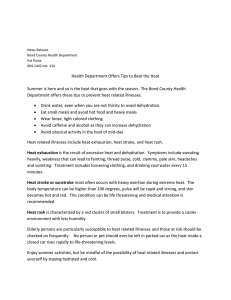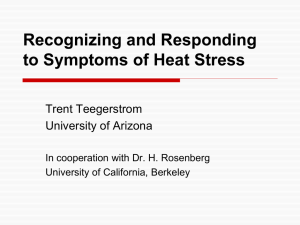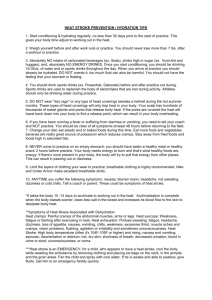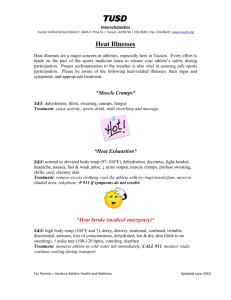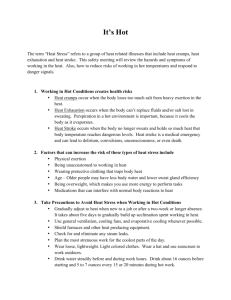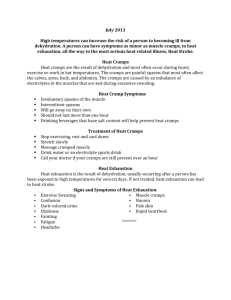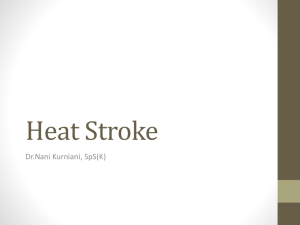Heat Stroke
advertisement
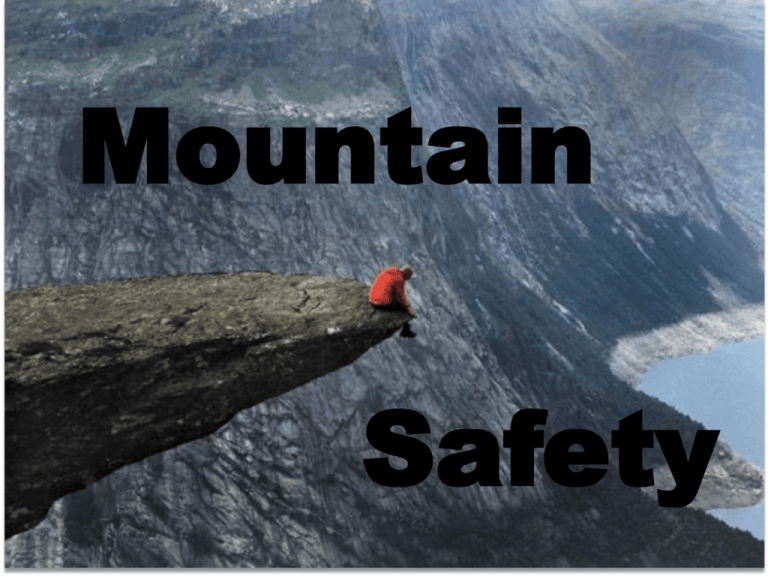
Mountain Safety MS 1_6: FA Basics (Dehydration & Heat Illnesses) Learning Intention: To equip you with the knowledge to avoid and treat heat illnesses. Success Criteria: By the end of this session everyone should be able to: • Describe what steps to take to avoid, recognise and treat heat-related illnesses when walking. Activities: 1. Discussion/Powerpoint: - What is a heat illness? - What can you do to avoid them? - How should you treat them? 2. Scenario What is a heat illness? Heat Illnesses (“Hyperthermia”) Severity Heat rash Sunburn Heat cramps Heat exhaustion Heat stroke American Meteorological Society Central North Carolina Chapter April 21, 2005 Heat Rash (prickly heat) Symptoms: Skin becomes reddened and may itch, feel prickly or hurt. First Aid: Practice good personal hygiene; keep the skin clean and the pores unclogged, allow skin to dry, wear loose clothing. Sunburn Symptoms: Skin becomes reddened, pain, blistering in severe cases. First Aid: Move into shade or cover minor burns with light cloth, frequent sips of water, cool skin by sponging with water, apply after-sun. Heat Cramps: Symptoms: Cramping of either active muscles (arms, legs) or involuntary (usually abdominal) muscles (or both). First Aid: Replenish electrolytes through drinking of fluids such as sports drinks etc. Rest in a cool environment. Heat Exhaustion: Symptoms: Nausea, dizziness, weakness headache, blurred vision, profuse sweating, cold/wet (clammy) grayish skin, unconsciousness, coma and death. First Aid: Lie down in a cool location, administer fluids if conscious. If unconscious, seek medical care. Heat Stroke: Symptoms: Chills, restlessness, irritability, euphoria, red face and skin, disorientation, hot/dry skin (not always), collapse, unconsciousness, convulsions and death. First Aid: Immediate, aggressive cooling of the victim’s body using wet cloths, immersion into cold water or alcohol wipes. Contact emergency services ASAP! Avoidance Sun-hat and or sun-screen Remove clothing layers Stop & rest Move into shade Drink little & often to avoid dehydration Dehydration fluid loss time* effect & symptoms (* timing may vary based on intensity of exercise and heat/humidity) 0.75 L 1 hr 1.5 L 2-3 hrs loss of endurance, start to feel thirsty, feel hot, uncomfortable 2.25 L 3-4 hrs loss of strength, loss of energy, moderate discomfort 3L 3.5-4 L 4-5 hrs 5-6 hrs cramps, headaches, extreme discomfort 5+ L 7+ hrs heat stroke, collapse, unconsciousness unnoticed (at 1.5% weight loss you are considered dehydrated) heat exhaustion, nausea, faint taken from: OH&S Canada Volume 69, Number 5, page 52, May 2000 What to drink: • Water is the best; juices are also good (juices contain energy restoring glucose). • Electrolyte (sports) drinks (e.g. Powerade) are usually not needed (but can be used for first aid for cramps). • Stay away from caffeinated carbonated, diet drinks and alcohol as they take water out of your body. How Much Water is Enough? • More than you want just to satisfy your thirst • Sources of water are: 1. Fluids – ½ pint = 250 mL every 30-60 min 2. Foods - fruit & veggies are 90% water • Not too cold Eat Healthily You can and should replace essential elements lost during sweating; Eat a balanced diet rather than taking salt tablets or drinking expensive sports drinks. Watch out for each other! • Someone heading into a heat stroke will no longer realise what is happening to him/her • It is vital that group members be able to recognise what is happening and intervene • Without quick attention, the person may die! Treatment General advice: Lie down in shade Sip water Remove outer clothing Cool with damp cloth, especially head & neck Questions?
